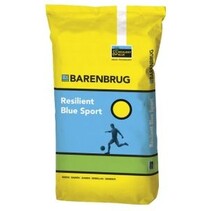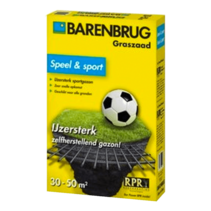Sport grass seed is specially developed for larger lawns that are used intensively for playing and walking!
Want to buy Grass seed for sports fields?
Sports grass seed is specially developed for somewhat larger lawns that are used intensively for playing and walking. The lawn is extra strong with an even, dense sod so it tolerates playing and sports well. This type of grass is also very resistant to drought and heat. As a result, it requires minimal maintenance. And should maintenance still be necessary, this grass is easy to mow short. In short, it is grass that performs at its best all year round!
What is sports grass?
The name says it all: Sports grass is a type of grass that can be played on intensively. Sports grass often consists mainly of ryegrass and a percentage of meadow fescue and/or red fescue. The mixture creates a strong, dense and stiff turf. So should you have children who like to play (ball) games on the grass or maybe you want to create a sports field. It doesn't matter, because with sports grass seed you will have a performing and reliable turf all year round!
When to sow sport grass?
It is best to sow sports turf in spring or autumn. During these seasons, the soil is often moist and the soil temperature is usually neither too hot nor too cold. To get the best sowing result, it is important that the soil temperature is at least 10°C. If, for example, it is still freezing at night but you have sown grass the day or week before, there is a risk that the young grass plants will be damaged. So keep a close eye on the weather forecast before you go into the garden!
What is the difference between sport grass and play grass?
Sports grass mixtures are ideal when you use the turf for constant, intensive treading. Sports grass generally has a high percentage of ryegrass. This is precisely why it is often used at sports clubs. Perennial ryegrass is a grass species that grows quickly and also recovers quickly, should there ever be a bald spot in the lawn. So during the summer break, many sports clubs sow grass mixtures with a high ryegrass content, so that the sports fields look good again in no time. Because there is a lot of ryegrass in sports grass mixtures, it has a somewhat lower ornamental value and needs to be mowed regularly. Even though playgrass can withstand regular walking and playing on it, it is generally just a little weaker than sport grass. This is because playgrass usually contains more red fescue. Red fescue is less vigorous than ryegrass, but has a higher ornamental value. Playgrass, because it contains a reasonable amount of red fescue, usually performs better in the shade than sports grass.
Advantages of sport grass
Sports and playing grasses are one of our best-selling grass types. This makes sense, as it produces a sod that can take a good deal of wear and requires little maintenance. Sports turf has numerous advantages:
Intensive use
As mentioned earlier, sports turf often has several strong grass varieties in the mix that can withstand high treading tolerance. The grass can therefore be used intensively to very intensively on a regular basis.
Maintenance
Sports turf requires slightly more maintenance than playgrass, but much less many other grass mixtures. Of course, it is important that the grass is sufficiently watered and mowed regularly.
Mowing
Sports grass can be mowed reasonably short, which gives it excellent ornamental value. Ideally, the grass should be cut at a height of about 3-4 centimetres. During the warm summer months, it is better to leave the grass a little longer. During the growing season (April - September), grass requires the most maintenance. If you want to keep the grass neat and short, you can cut it 1-2 times a week to the height mentioned above.









